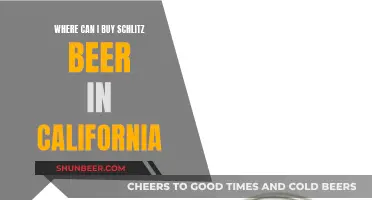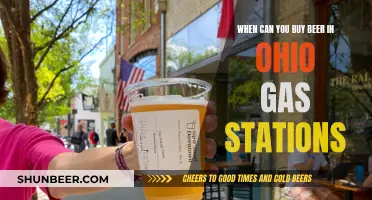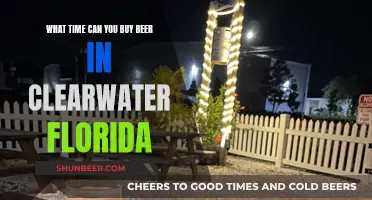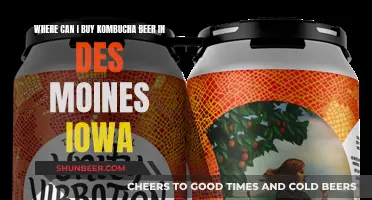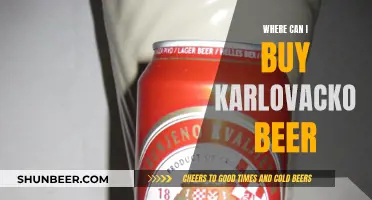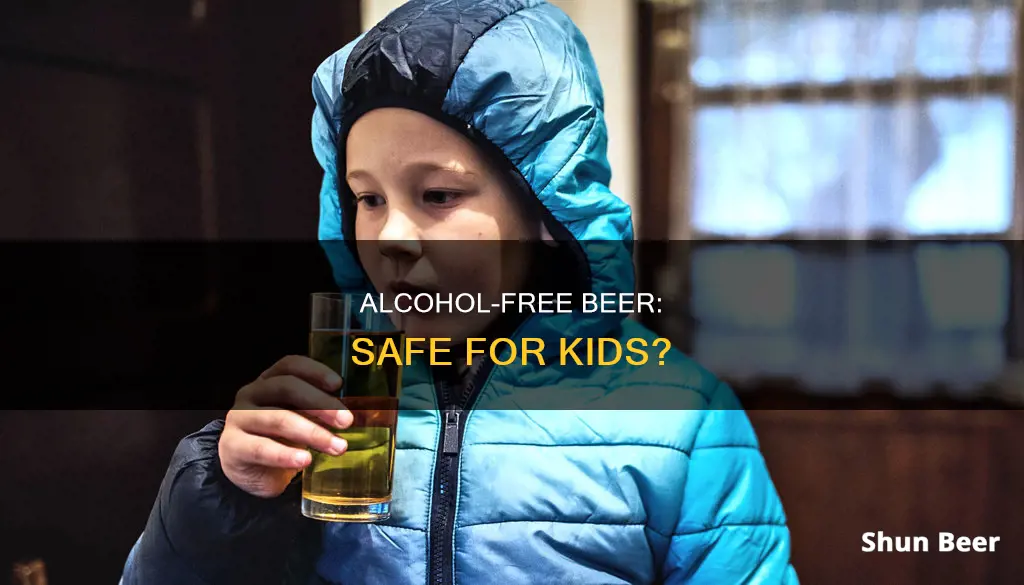
Alcohol-free beer is a divisive topic when it comes to whether or not it should be sold to minors. In many places, alcohol-free beer is treated the same as regular beer, and not sold to minors, despite the fact that it contains little to no alcohol. In the US, for example, some states require purchasers of alcohol-free beer to be 21, which is the country's legal drinking age. In other states, however, there is no age restriction. In the UK, there is no age limit on alcohol-free beer, and it can be purchased by anyone. The reasoning behind restricting the sale of alcohol-free beer to minors is to avoid promoting alcohol to children and to make it easier to enforce rules regarding alcoholic drinks. On the other hand, some argue that alcohol-free beer is not inherently harmful to minors and that it can even promote healthy habits.
What You'll Learn

Alcohol-free beer may still contain trace amounts of alcohol
Alcohol-free beer is not truly alcohol-free. While there may be no more than 0.5% ABV (alcohol by volume) in some varieties of alcohol-free beer, the remaining traces of alcohol still make the beer technically not alcohol-free. This is because, legally, anything that contains noticeable amounts of alcohol cannot be called alcohol-free. Generally, alcohol-free beers may contain anywhere from 0.3-0.5% ABV, and even this small amount of alcohol is enough to be detected by a breathalyser.
In the United States, brewers can label beer as "non-alcoholic" even if it has small amounts of alcohol. The threshold for non-alcoholic beer, and non-alcoholic beverages more broadly, is 0.5% ABV. That low percent of alcohol is similar to what you'd find in some fruit juices, breads, and super-ripe bananas. It's not enough to get you drunk or result in a hangover, but it's also not accurate to say that non-alcoholic beer is 100% free of alcohol.
In the UK, the legislation is more strict. "Alcohol-free" beers are allowed up to 0.05% ABV, with beers between 0.05% and 0.5% given the term "de-alcoholised". However, you can still buy 0.5% beer labelled as "alcohol-free" in the UK because there's no stopping producers from abroad labelling their 0.5% brews as "alcohol-free" and selling them in the UK. Some UK producers of 0.05% to 0.5% beer use the "alcohol-free" label (with caveats) to compete more fairly with foreign producers. Even beers labelled as "0%" could contain trace amounts of alcohol, as it can be difficult to remove it all. Hence the 0.05% – rather than 0% – limit for alcohol-free drinks under UK legislation.
In Europe, beers with an alcohol content of less than 0.5% ABV are considered alcohol-free, while in Australia, beverages with an alcohol content of less than 0.5% ABV are considered non-alcoholic.
Therefore, although alcohol-free beer may be an option for those who are looking to reduce their alcohol consumption, it is still important to be aware that there is still a low amount of alcohol in the beverage.
Buying Beer in Roswell, GA: Sunday Laws Explained
You may want to see also

Alcohol-free beer is often treated the same as alcoholic beer by retailers
There are a few reasons why retailers treat alcohol-free beer the same as alcoholic beer. Firstly, they want to avoid promoting alcohol to children. While alcohol-free beer may not contain much alcohol, or any at all, its packaging and appearance are almost identical to alcoholic beer. This means that allowing minors to buy alcohol-free beer could indirectly promote alcoholic beer to them. Many alcohol companies that produce alcohol-free beer also produce alcoholic drinks, and their marketing strategies for alcohol-free beer could be seen as targeting underage drinkers.
Secondly, treating alcohol-free and alcoholic beer the same makes it easier for retailers, pubs, and bars to enforce rules regarding alcoholic drinks. Staff can struggle to distinguish between customers drinking alcohol and those drinking non-alcoholic products, so treating all beer the same helps them monitor what customers are consuming. In shops, point-of-sale systems can flag the differences between alcohol-free and alcoholic beer to prevent staff from accidentally selling alcoholic products to minors.
In some places, there are laws that restrict the sale of non-alcoholic beer to minors. For example, in Pennsylvania, the sale of non-alcoholic beers to persons under the age of 21 is prohibited. However, in many places, it is not illegal to sell alcohol-free beer to minors. For example, in the UK, drinks under 0.5% ABV are not legally considered "alcohol" and are not subject to the same restrictions as alcoholic drinks. Despite this, many UK retailers still choose to restrict the sale of alcohol-free beer to minors.
Overall, retailers, pubs, and bars that treat alcohol-free beer the same as alcoholic beer are focused on society's best interests. They want to protect children from the dangers of alcohol and avoid normalising alcohol consumption for minors.
Gluten-Free, Alcohol-Free Beer: Where to Buy?
You may want to see also

Alcohol-free beer is indistinguishable from alcoholic beer
Alcohol-free beer is often treated the same as alcoholic beer by pubs, bars, and retailers. This is because the packaging and the drink itself are almost indistinguishable from alcoholic beer.
Alcohol-free beer is a relatively new product on the market, and its popularity is rising rapidly. Brewers are making craft non-alcoholic beers that taste just like the real thing. The main difference between non-alcoholic and alcoholic beers is the alcohol content. Alcoholic beers typically have an alcohol content ranging from 2% to 12%, while non-alcoholic beers have zero to very little alcohol content (less than 0.5% alcohol by volume). In many cases, the non-alcoholic beer is indistinguishable from its alcoholic counterpart.
Non-alcoholic beers are typically brewed using one of four major methods: controlled fermentation, dealcoholization, dilution, or simulated fermentation. In all four scenarios, brewers use standard beer ingredients to maintain that familiar hoppy beer taste without the alcohol punch. Along with the selected recipe, these various approaches determine what the brew will look, smell, and taste like.
The indistinguishable nature of non-alcoholic beer from alcoholic beer has led to concerns about promoting alcohol to minors. Even though non-alcoholic beer may not contain much alcohol, or any at all, its similarity to alcoholic beer in terms of packaging and taste could indirectly promote alcoholic products to minors. This has led to restrictions on the sale of non-alcoholic beer to minors, with retailers and pubs treating it the same as alcoholic beer to avoid promoting alcohol to children and to make it easier to enforce rules regarding alcoholic drinks.
While this may be inconvenient for some, the focus is on protecting children from the dangers of alcohol and preventing the normalization of alcohol in society, especially among minors.
Montana Beer Laws: Sunday Sales Explained
You may want to see also

Alcohol-free beer may appeal to children
Furthermore, the availability of alcohol-free beer in supermarkets and its placement alongside everyday groceries can contribute to its appeal to children. It becomes more accessible and normalised as a product, especially when compared to alcoholic beverages that are typically restricted to licensed stores or specific sections within supermarkets. Alcohol-free beer may also be perceived as a safer or healthier alternative to alcoholic drinks by children and their parents, making it seem like a more acceptable choice for minors.
In addition, alcohol-free beer can contain trace amounts of alcohol, typically up to 0.5% ABV. While this is significantly lower than the alcohol content in traditional beer, it still contributes to the appeal of these beverages to children. The presence of any amount of alcohol can be enticing to minors, especially those who are curious about drinking or seeking to experiment.
Lastly, the decision to allow children to consume alcohol-free beer rests with their parents or guardians. Some parents may view these beverages as a way to introduce responsible drinking habits or normalise alcohol consumption within appropriate contexts, such as family celebrations. However, this approach can be controversial, as there are concerns that early exposure to the taste and branding of alcohol-free beer may encourage an earlier interest in alcohol and potentially lead to increased consumption of alcoholic beverages later in life.
Buying Beer in North Carolina: Grocery Store Guide
You may want to see also

Alcohol-free beer may be purchased by minors in some countries
Alcohol-free beer is often treated the same as alcoholic beer by pubs, bars, and shops. This means that alcohol-free beer is usually not sold to minors, even though it is legal to do so in many places. However, in some countries, alcohol-free beer may be purchased by minors.
In the United States, for example, beverages containing less than 0.5% alcohol by volume (ABV) are legally considered non-alcoholic. As a result, non-alcoholic beer can be sold to people under the age of 21 in many US states, including Texas, Minnesota, Wisconsin, New Jersey, Illinois, Washington, D.C., Alaska, and Hawaii. In these states, minors are allowed to buy and consume non-alcoholic beer, although some stores may still choose to restrict sales to those under 21.
In the United Kingdom, there is no age restriction on the purchase of drinks with an ABV of less than 0.5%, which includes alcohol-free beer, shandy, and some chocolates with alcohol. While ID may still be requested when purchasing these drinks, it is not a legal requirement.
In Australia, the Liquor Control Reform Act states that it is only unlawful to sell beverages with an alcoholic content greater than 0.5% by volume to minors. Therefore, non-alcoholic beer can be purchased by those under the age of 18. However, there are concerns that the marketing of alcohol-free products like Carlton Zero in supermarkets normalises alcohol for children and could encourage parents to offer these drinks to their kids.
In Sweden, beer containing 2.8-3.5% ABV (known as Folköl or "People's Beer") can be sold to people over 18 in any convenience store, while stronger beer must be purchased in state-run liquor stores by those over 20. Beer below or equal to 2.25% ABV is not subject to age restrictions, but some stores voluntarily choose not to sell it to minors.
While the laws in these countries allow minors to purchase alcohol-free beer, the decision to sell to minors ultimately depends on the policies of individual companies and stores. Some companies, like AB-Inbev and the Portman Group, have policies that cover the promotion and sale of non-alcoholic drinks to minors to avoid promoting alcohol to children and to make it easier to enforce rules regarding alcoholic drinks.
Stroh's Beer: Where to Buy and Its History
You may want to see also
Frequently asked questions
It depends on where you live. In some places, like the UK, there are no age restrictions on alcohol-free beer. However, in other places, like the US, it varies by state. Some states, like Texas, Minnesota, Wisconsin, New Jersey, Illinois, Washington D.C., Alaska, and Hawaii, don't require you to be 21 to buy it, while others do.
There are a few reasons. Firstly, alcohol-free beer usually contains a small amount of alcohol (up to 0.5%), so it could be harmful to minors or make it easier for them to access alcoholic drinks. Secondly, it can be hard for staff to distinguish between alcoholic and non-alcoholic drinks, especially in pubs and bars, so restricting alcohol-free beer can make it easier to enforce rules around alcoholic drinks. Finally, allowing alcohol-free beer to be sold to minors could indirectly promote alcoholic drinks to them.
While alcohol-free beer contains very little alcohol, there is a risk that it could be a "gateway" to drinking for minors, leading to health issues or dependency on alcohol. There is also a lack of research on the consequences of drinking these products for pregnant people or minors.
Yes, some alternatives include light" beers, which have reduced alcohol content, or "near beer", which contains very little or no alcohol and was popular during Prohibition in the US. However, it's important to note that the availability of these alternatives may vary by region and that some places may still restrict their sale to minors.


